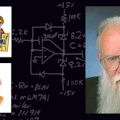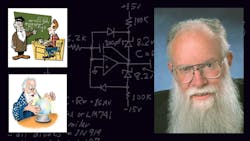A few dozen years ago, somebody asked me how to compute the transform between a TEE (or WYE) of resistors and the DELTA of resistors shown in the figure. I did all of the calculations and posted a copy of them inside a cabinet. The equations stayed there for over 10 years, until I neglected to transfer them to my new cabinet. Now, because somebody asked me to, I must do them again. Note that I show a tentative connection among the three legs of each network, as if to summing point, ground, and VOUT, which is typical. But these resistor networks can be connected to any circuit.
If you tell me your values for a Tee (or Wye), I can choose the right R values and make a Delta, and the resistor networks will be perfectly equivalent for their resistance. You won't be able to tell them apart (except perhaps for their capacitive strays). Conversely, if you have a Delta network of resistors, I can make a perfect equivalent with a Wye. So why would anybody use a Tee (or Wye) instead of a real resistor?
You might not have a 100-MΩ resistor lying around if you need a 100-MΩ feedback resistance for an op amp. But if you did, it might have poor quality and a poor tempco. With a decent RN65D 10-MΩ film resistor, you could put that in a Tee as R1, with R2 = 9 kΩ, and R3 = 1 kΩ (both RN55D, ±1%). We'll call this Case 1, and it will give you a feedback resistance, RC, of 100 MΩ, with pretty good stability and tempco. (The equations for RC below would indicate 100.01 MΩ, but that's not a significant discrepancy.)
If you need to do some really high-impedance work, you could go out and buy a 1010-Ω resistor for R1 and use 10 kΩ/100 Ω as R2/R3 to get a feedback resistance of 1012 Ω (Case 2). Sometimes a 1010-Ω resistor has better tolerances, better tempco, and better stability than a higher value, such as 1012 Ω. Alright, this sounds like a great invention, so why not just do it?
The reason is because the output accuracy and stability are degraded. Let's go back and look at Case 1. A good op amp's output may still be pretty stable, but it's likely to be 10 times more drifty or noisy than if you used a real 100-MΩ resistor. The increase in the noise gain is the problem. One way to look at this is that you must get a feedback resistance of 100 MΩ, but the RB of about 10 MΩ to ground causes the noise gain (ratio of VOUT per VOS) to rise to at least 10 (maybe more). Every 1 mV of the op amp's VOS causes 10 mV of offset on the output. Every microvolt of noise causes 10 µV of noise at the output.
In Case 2, the noise gain is up considerably, from 1 to 100. So in many cases, using a Tee network for the feedback resistance of an op amp is tolerable only if you can convince yourself that the excess noise and drift (as well as the decreased bandwidth) are acceptable. When is a good time to use a Tee network? A few situations come to mind:
(A) If you only need to use a noise gain ( = 1 + R2/R3) in the range of 1.2 to 2, to let you trim the gain, using a pot.
(B) When you're only going to use a noise gain of about 1.5 to 2 or 3, to let you adjust the feedback resistance (the gain) to the value you need, that's not a standard R value, such as 3,141.6 MΩ.
(C) If you're trying to get broad bandwidth, and the lower value of R1 provides higher frequency response be-cause your value of R1 is lower than the feedback resistance—given a fixed amount of capacitance across R1. That may help your response, but keep the noise gain to a fairly small value—usually less than 5 or 10. Still, you should implement good layout to minimize the capacitance across R1.
(D) When you want to engineer the R2/R3 ratio with a special tempco, to compensate for a poor tempco in R1. (See "What's All This Thermistor Stuff, Anyhow?" Electronic Design, Jan. 6, 1997, p. 171.)
Other than that, it's usually a poor idea to use a Tee network with R2/R3 greater than 2 or 3, unless you can prove that the advantages are good and the disadvantages acceptable. My reply is directed to the reader who asked, "What's wrong with using a Tee network, anyhow?"
How to compute the R values for the Wye-Delta Transform: If you just read the open-circuit voltage at the "input" node and apply a voltage between VOUT and ground, you can easily see that R2/R3 = RC/RB, or R2 = R3 (RC/RB). If you ground both the VOUT and the ground, it's easy to see that the conductance from the input to ground is:
(1/RB + 1/RC) = 1/(R1 + R2||R3)
Substitute the first equation into the second equation to get:
RC = (R1R2 + R1R3 + R2R3)/R3
Similarly:
RB = (R1R2 + R1R3 + R2R3)/R2,
RA = (R1R2 + R1R3 + R2R3)/R1
Likewise, one can compute the reverse transform:
R3 = RARB /(RA + RB + RC),
R2 = RARC /(RA + RB + RC),
R1 = RBRC /(RA + RB + RC)
So now you too can paste a copy of these equations inside your resistor cabinet, and now you know why Tee networks won't give you something for nothing!
All for now. / Comments invited!
RAP / Robert A. Pease / Engineer
[email protected]—or:
Mail Stop D2597A
National Semiconductor
P.O. Box 58090
Santa Clara, CA 95052-8090
I don't think I have this in any book I know. Have you tried the Web? Or a good library? Sliding a piece (or rotating a disk) of aluminum through a strong magnetic field generates a lot of "drag." I'm sure this would work well with an electromagnet, as well as with a permanent magnet. Obviously you can't turn an electromagnet on or off very fast, but this will work, if clean friction is what you need. Have fun!!—RAP
About the Author

Bob Pease
Bob obtained a BSEE from MIT in 1961 and was a staff scientist at National Semiconductor Corp., Santa Clara, CA, for many years. He was a well known and long time contributing editor to Electronic Design.
We also have a number of PDF eBooks by Bob that members can download from the Electronic Design Members Library.
